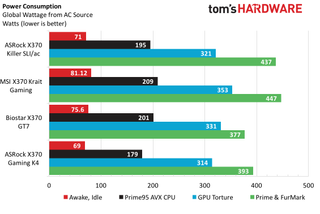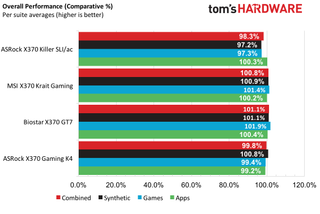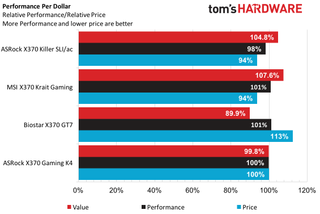ASRock X370 Killer SLI/ac Motherboard Review
Why you can trust Tom's Hardware
Efficiency, Overclocking & Final Thoughts
The ASRock X370 Killer SLI/ac inherits a lot of this section from its brother, the ASRock X370 Gaming K4, due to similar component choices and placement. At idle, the Killer burns 3% more power than our efficiency king, and both load conditions continue a similar trend by slightly lagging the leader but edging out both the MSI and Biostar samples. Unfortunately, full system stress is sometimes an artifact of sample times and Furmark lining up just right with Prime95. Overall, a 2nd place power win is impressive for this Killer.

Temperatures follow suit, and utilizing the Noctua U12 shows better performance compared to the Biostar and MSI Krait. The ASRock X370 Gaming K4 benefits here by using the monstrous Noctua dual fan product (in that review, we used the NH-D15 SE-AM4 cooler from Noctua), but regardless, either heatsink and motherboard combo work well in this chassis.

[*For MSI X370 Krait we observed that the sensors were tracking differently than with previous boards, so we had to reverse the nameing convention of the CPU thermal sensors. CPU Diode1 appears to track with other Ryzen 1700X installations.]
After scrutinizing our data, it’s unfortunate to see the ASRock X370 Killer SLI/ac lagging by 3% compared to the average in all metrics except applications. On the bright side, though, the odds are not stacked in its favor with the introduction of the 4K monitor and graphical hiccups on the synthetic tests. We believe this product would have performed similar to the ASRock X370 Gaming K4, putting this board into the middle of the pack.

The full system stress value skewed the efficiency results in the Gaming K4 and Biostar’s favor. Even factoring out the full system stress only barely puts the Killer SLI/ac in second place, and that pesky performance metric continues to plague this system.

Overclocking
This Ryzen 7 1700X has been a complete buzzkill in the silicon lottery, but it has proven to be fairly consistent across samples regarding both voltage and frequency. Putting in my standard settings (as seen in the UEFI sections on page 2), this sample reached a stable overclock of 3.875 GHz for an overnight run of Prime95 while running at 1.3875V. Granted, the Noctua has shown that it runs really hot under this much stress; but the system was stable and did not show signs of giving up during the extended torture test.

Our main take away from overclocking, though, comes in the memory department. As much as I hate overclocking memory, due diligence pays off. Starting with UEFI P2.40 enables me to run the standard DDR4-2400MHz for only the G.Skill Trident-Z memory kit when fully populated. Removing two sticks grants me 2933 MHz speeds, but 3200 MHz just wasn’t stable. And the HyperX Predator kits were complete letdowns, not letting me run any configurations above 2133 MHz.

Determined to succeed, updating to P2.5 was the cat’s pajamas. Instantly, half populated HyperX Predator DIMMs ran similarly to the G.Skill kits with stability achievable at DDR4-2933. The Predator configuration did not run above 2666 MHz with DIMM slots fully populated, but this is a drastic improvement from where we were at launch day. Switching back over to Trident-Z, fully populated DDR4-3200 only produced errors during moderate to heavy usage. Fully populated DDR4-2933 is where we settled, and we can now sleep soundly at night knowing that memory seems to be fixed on at least this AMD platform.
Value
The ASRock X370 Gaming K4 sets the bar for all metrics here, representing a near perfect average representation for value, performance, and price at the time of publication. For the Killer SLI/ac, performance has been back and forth. But lagging behind the average by nearly 2% does not completely invalidate a product’s existence. It only proves that testing methodologies, software version releases, and the current phase of the moon can impact results both in favor and against any particular sample. Heavily in favor for the Killer though, is price. Shaving $10 off the Gaming K4 makes this sample more appealing, while providing a slightly larger feature set and still delivering similar fundamental designs.

The ASRock X370 Killer SLI/ac at first felt like an attempt to repackage a product with a different skin. However, this repackaging grants us WiFi, similar overclocks, and average efficiency, while dolling out value comparable to our other Recommended award winner, the MSI X370 Krait Gaming. It is only fitting that we do the same here, especially when the ASRock X370 Killer SLI/ac ditches the red and black and gives customers what they need.
MORE: Best Motherboards
MORE: How To Choose A Motherboard
MORE: All Motherboard Content
Stay on the Cutting Edge
Join the experts who read Tom's Hardware for the inside track on enthusiast PC tech news — and have for over 25 years. We'll send breaking news and in-depth reviews of CPUs, GPUs, AI, maker hardware and more straight to your inbox.
-
azizisalmane Nice Review, I just wanted to ask you a question, I have the same motherboard, but when i OC my RAM to 2933mhz (which is the max frenquency where windows won't crash) the boot time is like WAY LONGER, (i'm talking about the pre-splash boot, not the windows one), it usually takes like 6 seconds or 7 tops for it to show the asrock logo when on 2134mhz, but once i go up to 2933, the boot time goes up to like 17 seconds. then when it gets to windows it boots up normally within 4 seconds. Have you ever encountered this problem when testing ?! (I also updated the bios but in vain)Reply -
TheTerk Yes, this is likely due to "Advanced Training" options within the UEFI (sorry if that's not the specific name in the menus.) This feature enables the BIOS to do some stability testing on the interface to confirm that it is reliable within the training routine. Each loop of the training can take a few seconds, so your memory interface likely took a few tries to get reliable results.Reply
I'd run a memstress test on your platform to confirm 2933 is stable. -
azizisalmane Thank you So much for your fast answer, well then i guess i'll have to do the memstress test to see if it's stable !! thank you so much again you were a great helpReply -
lightofhonor 2933 is also where I have topped out on the same board. :-/ Trident-Z 3200 16GBx2.Reply -
Wingback18 i have the same board, no complaints . i believe is an awsome price to performance , the black white silver colors mix well with the case and the msi gaming x graphics card .Reply
the R5 1600X Oc well to 3.9 Ghz at 1.3975 V . the ram doesnt go pass 2933 Mhz , maybe one day Ill get those 3200Mhz , or when i get the other two modules .
the rgb is a nice , no too flashie or too much
i do have one question , why asrock put two usb headers on the board. whats the purpose of two ! can someone help me understand that desicion .
ps , two more pwm fan headers would have been perfect ! -
g-unit1111 Asrock's X370 offerings are very solid. I have the Taichi and love it. I almost went with this board, but the extra M2 port on the Taichi made it worth it.Reply -
Malik 722 it's not just the asrock who would put two usb headers on the board many motherboard manufactures put two usb headers on their boards aswell.you can use them to connect additional usb ports to the board and can also connect many other devices.Reply -
Wingback18 @MALIK 722 thanks for the answer, I been thinking . most cases only support thre usb headers , I wonder what elseReply
in the future I would like to one of them m.2 drives -
Malik 722 you see now these days all kinds of devices come equipped with usb interface or connectors and due to that increased connectivity the number of usb ports available on casings and on motherboards is not enough so that is why you see multiple usb headers on boards so that you can increase the number of ports internally and many board manufactures also give extra usb port bay with their expensive boards.Reply
